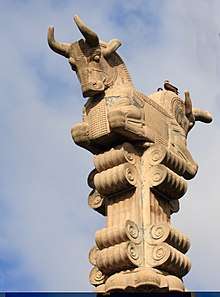Isfahan
Isfahan (Persian: اصفهان, romanized: Esfahān, [esfæˈhɒːn] (![]()
Isfahan اصفهان Spahān, Aspadana | |
|---|---|
City | |
   .jpg)  .jpg) 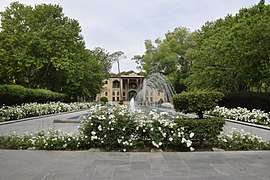 Top-bottom, R-L: Naqsh-e Jahan Square View from Keisaria gate, Khaju Bridge, Si-o-se-pol, Chehel Sotoun, Flower Garden of Isfahan, Hasht Behesht, Shah Mousqe | |
 Seal | |
| Nickname(s): Nesf-e Jahān (Half of the World) | |
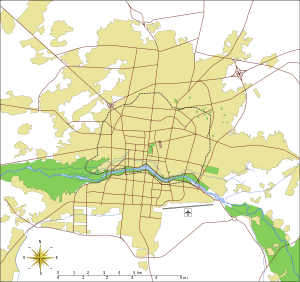 Isfahan | |
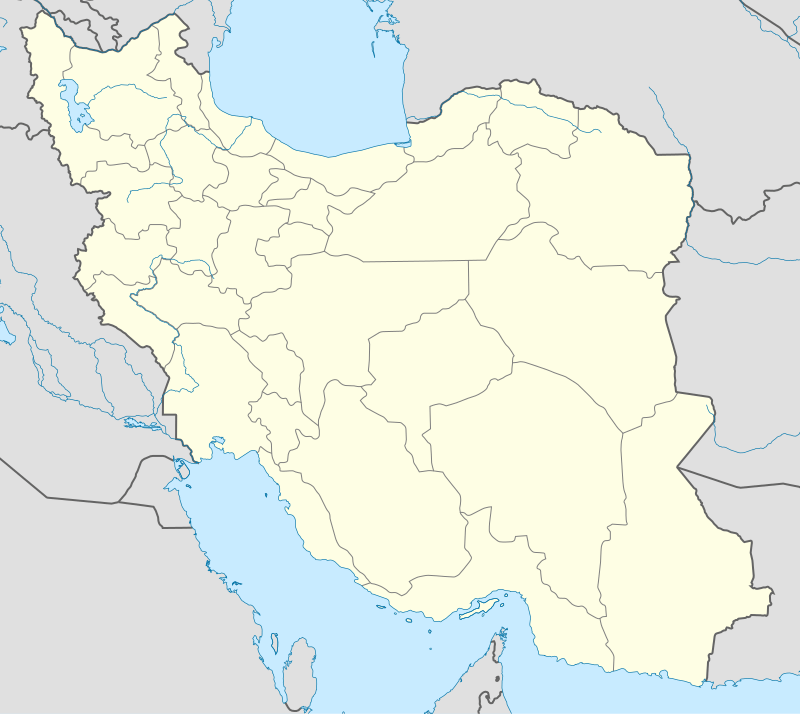 Isfahan Isfahan in Iran | |
| Coordinates: 32°38′41″N 51°40′03″E | |
| Country | |
| Province | Isfahan |
| County | Isfahan |
| District | Central |
| Government | |
| • Mayor | Ghodratollah Norouzi |
| • City Council | Fathollah Moein (Chairman) |
| Area | |
| • Urban | 551 km2 (213 sq mi) |
| Elevation | 1,574 m (5,217 ft) |
| Population (2016 Census) | |
| • Urban | 2,000,000[2] |
| • Metro | 3,989,070[3] |
| • Population Rank in Iran | 3rd |
| Time zone | UTC+3:30 (IRST) |
| • Summer (DST) | UTC+4:30 (IRDT 21 March – 20 September) |
| Area code(s) | 031 |
| Climate | BWk[4] |
| Website | isfahan.ir |
Isfahan has a population of approximately 2.0 million,[5] making it the third-largest city in Iran after Tehran and Mashhad, but was once one of the largest cities in the world.
Isfahan is an important city as it is located at the intersection of the two principal north-south and east-west routes that traverse Iran. Isfahan flourished from 1050 to 1722, particularly in the 16th and 17th centuries under the Safavid dynasty when it became the capital of Persia for the second time in its history under Shah Abbas the Great. Even today the city retains much of its past glory.
It is famous for its Perso–Islamic architecture, grand boulevards, covered bridges, palaces, tiled mosques and minarets. Isfahan also has many historical buildings, monuments, paintings, and artifacts. The fame of Isfahan led to the Persian pun and proverb "Esfahān nesf-e- jahān ast": Isfahan is half (of) the world.[6]
The Naghsh-e Jahan Square in Isfahan is one of the largest city squares in the world. UNESCO has designated it a World Heritage Site.
Etymology
Isfahan is derived from Middle Persian Spahān. Spahān is attested in various Middle Persian seals and inscriptions, including that of Zoroastrian Magi Kartir,[7] and is also the Armenian name of the city (Սպահան). The present-day name is the Arabicized form of Ispahan (unlike Middle Persian, but similar to Spanish, New Persian does not allow initial consonant clusters such as sp[8]). The region appears with the abbreviation GD (Southern Media) on Sasanian numismatics. In Ptolemy's Geographia, it appears as Aspadana (Ἀσπαδανα), translating to "place of gathering for the army". It is believed that Spahān derives from spādānām "the armies", Old Persian plural of spāda, from which derives spāh (𐭮𐭯𐭠𐭧) 'army' and spahi (سپاهی, 'soldier', literally 'of the army') in Middle Persian.
History
| Year | Pop. | ±% p.a. |
|---|---|---|
| 1870 | 60,000 | — |
| 1890 | 90,000 | +2.05% |
| 1900 | 100,000 | +1.06% |
| 1920 | 80,000 | −1.11% |
| 1933 | 100,100 | +1.74% |
| 1942 | 204,600 | +8.27% |
| 1956 | 254,700 | +1.58% |
| 1968 | 444,000 | +4.74% |
| 1976 | 671,800 | +5.31% |
| 1986 | 986,800 | +3.92% |
| 1991 | 1,182,735 | +3.69% |
| 1996 | 1,327,283 | +2.33% |
| 2001 | 1,327,283 | +0.00% |
| 2006 | 1,689,392 | +4.94% |
| 2011 | 1,853,293 | +1.87% |
| 2016 | 1,961,260 | +1.14% |
| source:[9] | ||
Human habitation of the Isfahan region can be traced back to the Palaeolithic period. Recent discoveries archaeologists have found artifacts dating back to the Palaeolithic, Mesolithic, Neolithic, Bronze and Iron Ages.
Bronze Age
What was to become the city of Isfahan in later historical periods probably emerged as a locality and settlement that gradually developed over the course of the Elamite civilisation (2700–1600 BCE).
Zoroastrian era
Under Median rule, this commercial entrepôt began to show signs of more sedentary urbanism, steadily growing into a noteworthy regional centre that benefited from the exceptionally fertile soil on the banks of the Zayandehrud River in a region called Aspandana or Ispandana.
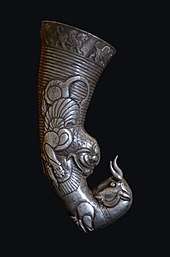
Once Cyrus the Great (reg. 559–529 BCE) had unified Persian and Median lands into the Achaemenid Empire (648–330 BCE), the religiously and ethnically diverse city of Isfahan became an early example of the king's fabled religious tolerance. It was Cyrus who, having just taken Babylon, made an edict in 538 BCE, declaring that the Jews in Babylon could return to Jerusalem (see Ezra ch. 1). Now it seems that some of these freed Jews settled in Isfahan instead of returning to their homeland. The 10th-century Persian historian Ibn al-Faqih wrote:
"When the Jews emigrated from Jerusalem, fleeing from Nebuchadnezzar, they carried with them a sample of the water and soil of Jerusalem. They did not settle down anywhere or in any city without examining the water and the soil of each place. They did all along until they reached the city of Isfahan. There they rested, examined the water and soil, and found that both resembled Jerusalem. Thereupon they settled there, cultivated the soil, raised children and grandchildren, and today the name of this settlement is Yahudia."[10]
The Parthians, in the period 247 BCE – 224 CE, continued the tradition of tolerance after the fall of the Achaemenids, fostering the Hellenistic dimension within Iranian culture and the political organisation introduced by Alexander the Great's invading armies. Under the Parthians, Arsacid governors administered the provinces of the nation from Isfahan, and the city's urban development accelerated to accommodate the needs of a capital city.
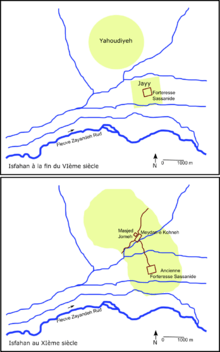
The next empire to rule Persia, the Sassanids (224 CE –651 CE), presided over massive changes in their realm, instituting sweeping agricultural reform and reviving Iranian culture and the Zoroastrian religion. Both the city and region were then called by the name Aspahan or Spahan. The city was governed by a group called the Espoohrans, who came from seven noble and important Iranian royal families. Extant foundations of some Sassanid-era bridges in Isfahan suggest that the Sasanian kings were fond of ambitious urban planning projects. While Isfahan's political importance declined during the period, many Sassanid princes would study statecraft in the city, and its military role developed rapidly. Its strategic location at the intersection of the ancient roads to Susa and Persepolis made it an ideal candidate to house a standing army, ready to march against Constantinople at any moment. The words 'Aspahan' and 'Spahan' are derived from the Pahlavi or Middle Persian meaning 'the place of the army'.[11] Although many theories have been mentioned about the origin of Isfahan, in fact little is known of it before the rule of the Sasanian dynasty (c. 224 – c. 651 CE). The historical facts suggest that in the late 4th and early 5th centuries, Queen Shushandukht, the Jewish consort of Yazdegerd I (reigned 399–420) settled a colony of Jews in Yahudiyyeh (also spelled Yahudiya), a settlement 3 km northwest of the Zoroastrian city of Gabae (it's Achaemid and Parthian name; Gabai was its Sasanic name, which was shortened to Gay (Arabic 'Jay') that was located on the northern bank of the Zayanderud River. The gradual population decrease of Gay (Jay) and the simultaneous population increase of Yahudiyyeh and its suburbs after the Islamic conquest of Iran resulted in the formation of the nucleus of what was to become the city of Isfahan. The words "Aspadana", "Ispadana", "Spahan" and "Sepahan", all from which the word Isfahan is derived, referred to the region in which the city was located.
Isfahan and Gay were both circular in design, a characteristic of Parthian and Sasanian cities.[12] However, this reported Sasanian circular city of Isfahan is not uncovered yet.[13]
Islamic era
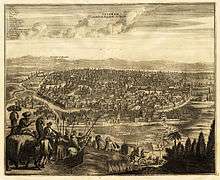
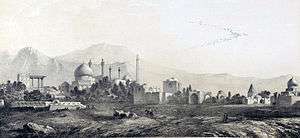
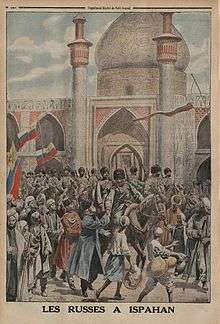
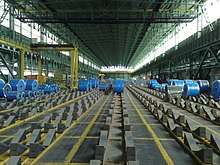
When the Arabs captured Isfahan in 642, they made it the capital of al-Jibal ("the Mountains") province, an area that covered much of ancient Media. Isfahan grew prosperous under the Persian Buyid (Buwayhid) dynasty, which rose to power and ruled much of Iran when the temporal authority of the Abbasid caliphs waned in the 10th century. The Turkish conqueror and founder of the Seljuq dynasty, Toghril Beg, made Isfahan the capital of his domains in the mid-11th century; but it was under his grandson Malik-Shah I (r. 1073–92) that the city grew in size and splendour.[14]
After the fall of the Seljuqs (c. 1200), Isfahan temporarily declined and was eclipsed by other Iranian cities such as Tabriz and Qazvin. During his visit in 1327, Ibn Battuta noted that "The city of Isfahan is one of the largest and fairest of cities, but it is now in ruins for the greater part."[15]
In 1387, Isfahan surrendered to the Turko-Mongol warlord Timur. Initially treated with relative mercy, the city revolted against Timur's punitive taxes by killing the tax collectors and some of Timur's soldiers. In retribution, Timur ordered the massacre of the city residents, and his soldiers killed a reported 70,000 citizens. An eye-witness counted more than 28 towers, each constructed of about 1,500 heads.[16]
Isfahan regained its importance during the Safavid period (1501–1736). The city's golden age began in 1598 when the Safavid ruler Shah Abbas I (reigned 1588–1629) made it his capital and rebuilt it into one of the largest and most beautiful cities in the 17th-century world. In 1598 Shah Abbas the Great moved his capital from Qazvin to the more central Isfahan; he named it Ispahān (New Persian) so that it wouldn't be threatened by the Ottomans. This new status ushered in a golden age for the city, with architecture and Persian culture flourishing. In the 16th and 17th centuries, thousands of deportees and migrants from the Caucasus, that Abbas and other Safavid rulers had permitted to emigrate en masse, settled in the city. So now the city had enclaves of Georgian, Circassian, and Daghistani descent.[17] Engelbert Kaempfer, who dwelt in Safavid Persia in 1684–85, estimated their number at 20,000.[17][18] During the Safavid era, the city contained a very large Armenian community as well. As part of Abbas's forced resettlement of peoples from within his empire, he resettled as many as 300,000 Armenians[19][20]) from near the unstable Safavid-Ottoman border, primarily from the very wealthy Armenian town of Jugha (also known as Old Julfa) in mainland Iran.[20] In Isfahan, he ordered the foundation of a new quarter for these resettled Armenians from Old Julfa, and thus the Armenian Quarter of Isfahan was named New Julfa.[19][20] Today, the New Jolfa district of Isfahan remains a heavily Armenian-populated district, with Armenian churches and shops, the Vank Cathedral being especially notable for its combination of Armenian Christian and Iranian Islamic elements. It is still one of the oldest and largest Armenian quarters in the world. Following an agreement between Shah Abbas I and his Georgian subject Teimuraz I of Kakheti ("Tahmuras Khan"), whereby the latter submitted to Safavid rule in exchange for being allowed to rule as the region's wāli (governor) and for having his son serve as dāruḡa ("prefect") of Isfahan in perpetuity, the Georgian prince converted to Islam and served as governor.[17] He was accompanied by a troop of soldiers,[17] some of whom were Georgian Orthodox Christians.[17] The royal court in Isfahan had a great number of Georgian ḡolāms (military slaves), as well as Georgian women.[17] Although they spoke both Persian and Turkic, their mother tongue was Georgian.[17] During Abbas's reign, Isfahan became very famous in Europe, and many European travellers made an account of their visit to the city, such as Jean Chardin. This prosperity lasted until it was sacked by Afghan invaders in 1722 during a marked decline in Safavid influence.
Thereafter, Isfahan experienced a decline in importance, culminating in a move of the capital to Mashhad and Shiraz during the Afsharid and Zand periods respectively, until it was finally moved to Tehran in 1775 by Agha Mohammad Khan, the founder of the Qajar dynasty. (See https://www.britannica.com/place/Tehran)
In the early years of the 19th century, efforts were made to preserve some of Isfahan's archeologically important buildings. The work was started by Mohammad Hossein Khan during the reign of Fath Ali Shah.[21]
Modern age
In the 20th century, Isfahan was resettled by a very large number of people from southern Iran, firstly during the population migrations at the start of the century, and again in the 1980s following the Iran–Iraq War.
Today, Isfahan produces fine carpets, textiles, steel, handicrafts, and traditional foods including sweets. There are nuclear experimental reactors as well as facilities for producing nuclear fuel (UCF) within the environs of the city. Isfahan has one of the largest steel-producing facilities in the region, as well as facilities for producing special alloys. Mobarakeh Steel Company is the biggest steel producer in the whole of the Middle East and Northern Africa, and it is the biggest DRI producer in the world.[22] The Isfahan Steel Company was the first manufacturer of constructional steel products in Iran, and it remains the largest such company today.[23]
The city has an international airport and a metro line.
There are a major oil refinery and a large airforce base outside the city. HESA, Iran's most advanced aircraft manufacturing plant, is located just outside the city.[24][25] Isfahan is also attracting international investment,[26] especially in the Isfahan City Center[27] which is the largest shopping mall in Iran and the fifth largest in the world.[28]
Isfahan hosted the International Physics Olympiad in 2007.
Geography
The city is located in the lush plain of the Zayanderud River at the foothills of the Zagros mountain range. The nearest mountain is Mount Soffeh (Kuh-e Soffeh), just south of the city.
Climate
Situated at 1,590 metres (5,217 ft) above sea level on the eastern side of the Zagros Mountains, Isfahan has an cold desert climate (Köppen BWk). No geological obstacles exist within 90 kilometres (56 miles) north of Isfahan, allowing cool winds to blow from this direction. Despite its altitude, Isfahan remains hot during the summer, with maxima typically around 35 °C (95 °F). However, with low humidity and moderate temperatures at night, the climate is quite pleasant. During the winter, days are cool while nights can be very cold. Snow falls an average of 7.8 days each winter.[29] The Zayande River starts in the Zagros Mountains, flowing from the west through the heart of the city, then dissipates in the Gavkhouni wetland.
| Climate data for Isfahan (1961–1990, extremes 1951–2010) | |||||||||||||
|---|---|---|---|---|---|---|---|---|---|---|---|---|---|
| Month | Jan | Feb | Mar | Apr | May | Jun | Jul | Aug | Sep | Oct | Nov | Dec | Year |
| Record high °C (°F) | 20.4 (68.7) |
23.4 (74.1) |
29.0 (84.2) |
32.0 (89.6) |
37.6 (99.7) |
41.0 (105.8) |
43.0 (109.4) |
42.0 (107.6) |
39.0 (102.2) |
33.2 (91.8) |
26.8 (80.2) |
21.2 (70.2) |
43.0 (109.4) |
| Average high °C (°F) | 8.8 (47.8) |
11.9 (53.4) |
16.8 (62.2) |
22.0 (71.6) |
28.0 (82.4) |
34.1 (93.4) |
36.4 (97.5) |
35.1 (95.2) |
31.2 (88.2) |
24.4 (75.9) |
16.9 (62.4) |
10.8 (51.4) |
23.0 (73.4) |
| Daily mean °C (°F) | 2.7 (36.9) |
5.5 (41.9) |
10.4 (50.7) |
15.7 (60.3) |
21.3 (70.3) |
27.1 (80.8) |
29.4 (84.9) |
27.9 (82.2) |
23.5 (74.3) |
16.9 (62.4) |
9.9 (49.8) |
4.4 (39.9) |
16.2 (61.2) |
| Average low °C (°F) | −2.4 (27.7) |
−0.2 (31.6) |
4.5 (40.1) |
9.4 (48.9) |
14.2 (57.6) |
19.1 (66.4) |
21.5 (70.7) |
19.8 (67.6) |
15.1 (59.2) |
9.3 (48.7) |
3.6 (38.5) |
−0.9 (30.4) |
9.4 (48.9) |
| Record low °C (°F) | −19.4 (−2.9) |
−12.2 (10.0) |
−8 (18) |
−4 (25) |
4.5 (40.1) |
10.0 (50.0) |
13.0 (55.4) |
11.0 (51.8) |
5.0 (41.0) |
0.0 (32.0) |
−8 (18) |
−13 (9) |
−19.4 (−2.9) |
| Average precipitation mm (inches) | 17.1 (0.67) |
14.1 (0.56) |
18.2 (0.72) |
19.2 (0.76) |
8.8 (0.35) |
0.6 (0.02) |
0.7 (0.03) |
0.2 (0.01) |
0.0 (0.0) |
4.1 (0.16) |
9.9 (0.39) |
19.6 (0.77) |
112.5 (4.43) |
| Average precipitation days (≥ 1.0 mm) | 4.0 | 2.9 | 3.8 | 3.5 | 2.0 | 0.2 | 0.3 | 0.1 | 0.0 | 0.8 | 2.2 | 3.7 | 23.5 |
| Average snowy days | 3.2 | 1.7 | 0.7 | 0.1 | 0.0 | 0.0 | 0.0 | 0.0 | 0.0 | 0.0 | 0.2 | 1.9 | 7.8 |
| Average relative humidity (%) | 60 | 51 | 43 | 39 | 33 | 23 | 23 | 24 | 26 | 36 | 48 | 57 | 39 |
| Mean monthly sunshine hours | 205.3 | 213.3 | 242.1 | 244.5 | 301.3 | 345.4 | 347.6 | 331.2 | 311.6 | 276.5 | 226.1 | 207.6 | 3,252.5 |
| Source 1: NOAA[30] | |||||||||||||
| Source 2: Iran Meteorological Organization (records)[31][32] | |||||||||||||
Culture
Main places
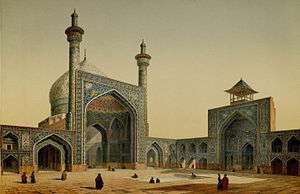
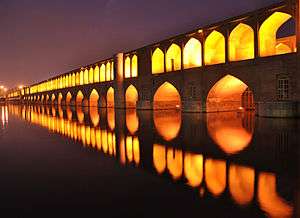

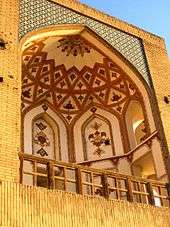
The city centre consists of an older section revolving around the Jameh Mosque, and the Safavid expansion around Naqsh-e Jahan Square, with nearby places of worship, palaces, and bazaars.[33]
Bazaars
- Shahi Bazaar – 17th century
- Qeysarie Bazaar – 17th century
Bridges
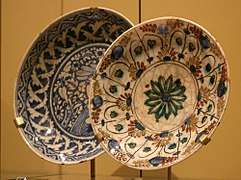
The bridges on the Zayanderud river comprise some of the finest architecture in Isfahan. The oldest bridge is the Shahrestan bridge, whose foundations were built by the Sasanian Empire (3rd–7th century Sassanid era); it was repaired during the Seljuk period. Further upstream is the Khaju bridge, which was built by Shah Abbas II in 1650. It is 123 metres (404 feet) long with 24 arches, and also serves as a sluice gate.
Another bridge is the Choobi (Joui) bridge, which was originally an aqueduct to supply the palace gardens on the north bank of the river. Further upstream again is the Si-o-Seh Pol or bridge of 33 arches. The building was built during the reign of Shah Abbas the Great by Sheikh Baha'i and connected Isfahan with the Armenian suburbs of New Jolfa. Armenian suburb of New Julfa. It is by far the longest bridge in Isfahan at 295 m (967.85 ft).
Another notable bridge is the Marnan Bridge.
Churches and cathedrals
- Bedkhem Church – 1627
- St. Georg Church – 17th century
- St. Jakob Church – 1607
- St. Mary Church – 17th century
- Vank Cathedral – 1664
Emamzadehs
- Emamzadeh Ahmad
- Emamzadeh Esmaeil, Isfahan
- Emamzadeh Haroun-e-Velayat – 16th century
- Emamzadeh Jafar
- Emamzadeh Shah Zeyd
Gardens and parks
- Birds Garden
- Flower Garden
- Nazhvan Recreational Complex
Houses
- Alam's House
- Amin's House
- Malek Vineyard
- Qazvinis' House – 19th century
- Sheykh ol-Eslam's House
Mausoleums and tombs
- Al-Rashid Mausoleum – 12th century
- Baba Ghassem Mausoleum – 14th century
- Mausoleum of Safavid Princes
- Nizam al-Mulk Tomb – 11th century
- Saeb Mausoleum
- Shahshahan mausoleum – 15th century
- Soltan Bakht Agha Mausoleum – 14th century
Minarets
- Ali minaret – 11th century
- Bagh-e-Ghoushkhane minaret – 14th century
- Chehel Dokhtaran minaret – 12 century
- Dardasht minarets – 14th century
- Darozziafe minarets – 14th century
- Menar Jonban – 14th century
- Sarban minaret
Mosques
- Agha Nour mosque – 16th century
- Hakim Mosque
- Ilchi mosque
- Jameh Mosque[34]
- Jarchi mosque – 1610
- Lonban mosque
- Maghsoudbeyk mosque – 1601
- Mohammad Jafar Abadei mosque – 1878
- Rahim Khan mosque – 19th century
- Roknolmolk mosque
- Seyyed mosque – 19th century
- Shah Mosque – 1629
- Sheikh Lotf Allah Mosque – 1618
Museums
- Contemporary Arts Museum Isfahan
- Isfahan City Center Museum
- Museum of Decorative Arts
- Natural History Museum of Isfahan – 15th century
Schools (madresse)
- Chahar Bagh School – early 17th century
- Harati
- Kassegaran school – 1694
- Madreseye Khajoo
- Nimavar school – 1691
- Sadr school – 19th century
Palaces and caravanserais
- Ali Qapu (The Royal Palace) – early 17th century
- Chehel Sotoun (The Palace of Forty Columns) – 1647
- Hasht-Behesht (The Palace of Eight Paradises) – 1669
- Shah Caravanserai
- Talar Ashraf (The Palace of Ashraf) – 1650
Squares and streets
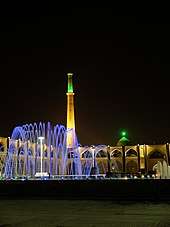
- Chaharbagh Boulevard – 1596
- Chaharbagh-e-khajou Boulevard
- Meydan Kohne (Old Square)
- Naqsh-e Jahan Square also known as "Shah Square" or "Imam Square" – 1602
Synagogues
- Kenisa-ye Bozorg (Mirakhor's kenisa)
- Kenisa-ye Molla Rabbi
- Kenisa-ye Sang-bast
- Mullah Jacob Synagogue
- Mullah Neissan Synagogue
- Kenisa-ye Keter David
Tourist attractions
The central historical area in Isfahan is called Seeosepol (the name of a famous bridge).
Other sites
- Atashgah – a Zoroastrian fire temple
- The Bathhouse of Bahāʾ al-dīn al-ʿĀmilī
- Isfahan City Center
- Jarchi hammam
- New Julfa – 1606
- Pigeon Towers[35] – 17th century
- Takht-e Foulad
Education
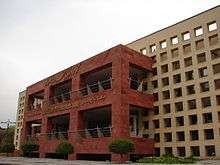
Aside from the seminaries and religious schools, the major universities of the Esfahan metropolitan area are:
- Universities
- Isfahan University of Art
- Isfahan University of Medical Sciences
- Isfahan University of Technology
- Islamic Azad University of Isfahan
- Islamic Azad University of Najafabad
- Islamic Azad University of Falavarjan
- Islamic Azad University of Majlesi
- University of Isfahan
- High schools
- Mofateh High School
- Farzanegan e Amin High School
- Harati High School
- Imam Mohammad Bagher Education Complex
- Imam Sadegh Education Complex
- Mahboobeh Danesh (Navaie)
- Pooya High School
- Saadi High School
- Sa'eb Education Complex
- Salamat High School
- Saremiyh High School
- Shahid Ejei High School
- Saeb High School
There are also more than 50 technical and vocational training centres in the province under the administration of Esfahan TVTO, which provide free, non-formal training programs.[36]
Transportation
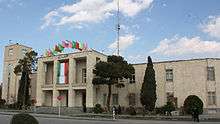
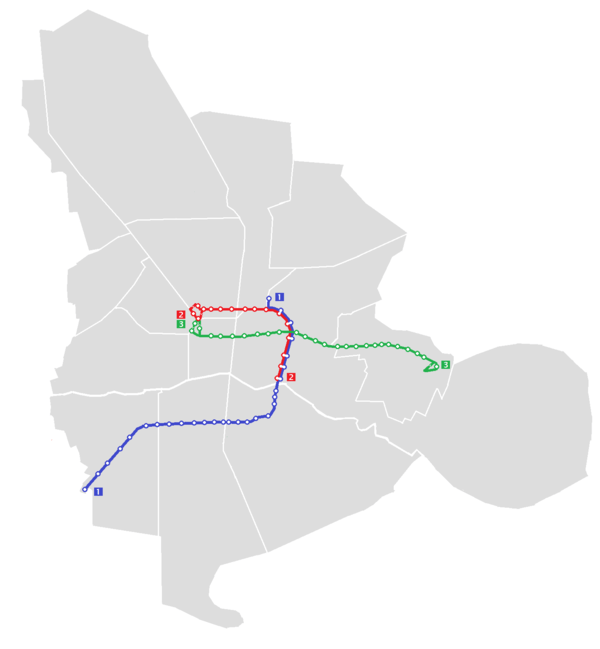

Roads
Over the past decade, Isfahan's internal highway network has been undergoing major expansion. Much care has been taken to prevent damage to valuable, historical buildings. Modern freeways connect the city to the country's major cities, including the capital Tehran (length approximately 400 km) to the north and Shiraz (200 km) to the south. Highways also service satellite cities surrounding the metropolitan area.[37]
Notable people
- Music
- Jalal Taj Esfahani (1903–1981), musician, singer and vocalist[39]
- Alireza Eftekhari (1956–), singer[40]
- Fard
- Leila Forouhar (1959–), pop singer[41]
- Hassan Kassai (1928–2012), musician[42]
- Nasrollah Moein (1951–), pop singer[43]
- Hassan Shamaizadeh, songwriter and singer[44]
- Jalil Shahnaz (1921–2013), tar soloist, a traditional Persian instrument[45]
- Film
- Rasul Sadr Ameli (1953–), director
- Sara Bahrami (1983–), actor[46]
- Homayoun Ershadi (1947–), Hollywood actor and architect
- Soraya Esfandiary-Bakhtiari (1956–2001), former princess of Iran and actress
- Asghar Farhadi (1972–), Oscar-winning director[47]
- Bahman Farmanara (1942–), director
- Jahangir Forouhar (1916–1997), actor and father of Leila Forouhar (Iranian singer)
- Mohamad Ali Keshvarz (1930–), actor[48]
- Mahdi Pakdel (1980–), actor[49]
- Kiumars Poorahmad (1949–), director[50]
- Soroush Sehhat (1965–), actor and director[51]
- Nosratollah Vahdat (1925–), actor[52]
- Craftsmen and painters
- Mahmoud Dehnavi (1927–), craftsman and artist[53]
- Mahmoud Farshchian (1930–), painter and miniaturist[54]
- Freydoon Rassouli (1943–), American painter born and raised in Isfahan[55]
- Bogdan Saltanov (1630s–1703), Russian icon painter of Isfahanian Armenian origin
- Political figures
- Ahmad Amir-Ahmadi (1906–1965), military leader and cabinet minister
- Ayatollah Mohammad Beheshti (1928–1981), cleric, Chairman of the Council of Revolution of Iran[56]
- Nusrat Bhutto, Chairman of Pakistan Peoples Party from 1979–1983; wife of Zulfikar Ali Bhutto; mother of Benazir Bhutto
- Hossein Fatemi, PhD (1919–1954), politician; foreign minister in Mohamed Mossadegh's cabinet
- Mohammad-Ali Foroughi (1875–1942), a politician and Prime Minister of Iran in the World War II era[57]
- Dariush Forouhar (August 1928 – November 1998), a founder and leader of the Hezb-e Mellat-e Iran (Nation of Iran Party)
- Hossein Kharrazi, chief of the army in the Iran–Iraq War[58]
- Mohsen Nourbakhsh (1948–2003), economist, Governor of the Central Bank of Iran
- Mohammad Javad Zarif (1960–), Minister of Foreign Affairs and former Ambassador of Iran to the United Nations[59]
- Religious figures
- Lady Amin (Banou Amin) (1886–1983), Iran's most outstanding female jurisprudent, theologian and great Muslim mystic (‘arif), a Lady Mujtahideh
- Amina Begum Bint al-Majlisi was a female Safavid mujtahideh
- Ayatollah Mohammad Beheshti (1928–1981), cleric, Chairman of the Council of Revolution of Iran[56]
- Abū Shujāʿ al-Iṣfahānī (5th c.) jurist and judge
- Allamah al-Majlisi (1616–1698), Safavid cleric, Sheikh ul-Islam in Isfahan
- Salman the Persian
- Muhammad Ibn Manda (d. 1005 / AH 395), Sunni Hanbali scholar of hadith and historian
- Abu Nu'aym Al-Ahbahani Al-Shafi'i (d. 1038 / AH 430), Sunni Shafi'i Scholar
- Seyyed Ali Qazi Askar (1954) Iran's supreme leader representative, in Haj
- Sportspeople
- Abdolali Changiz, football star of Esteghlal FC in the 1970s
- Mansour Ebrahimzadeh, former player for Sepahan FC, former head coach of Zobahan
- Ghasem Haddadifar, captain of Zobahan FC
- Ehsan Hajsafi, player for the Sepahan and Olympiacos FC
- Arsalan Kazemi, forward for the Oregon Ducks men's basketball team and the Iran national basketball team
- Rasoul Korbekandi, goalkeeper of the Iranian National Team
- Moharram Navidkia, captain of Sepahan FC
- Mohammad Talaei, world champion wrestler
- Mahmoud Yavari (1939-), football player, coach of Iranian National Team
- Sohrab Moradi (1988-), Olympic weightlifting gold medalist, world record holder of 105 kg category
- Milad Beigi (1991-) Olympic taekwando bronze medalist, world champion
- Writers and poets
- Mohammad-Ali Jamālzādeh Esfahani (1892–1997), author
- Hatef Esfehani, Persian Moral poet in the Afsharid Era
- Zhaleh Esfahani (1921–2007), poet and writer[60]
- Kamal ed-Din Esmail (late 12th century - early 13th century)
- Houshang Golshiri (1938–2000), writer and editor
- Hamid Mosadegh (1939–1998), poet and lawyer
- Mirza Abbas Khan Sheida (1880–1949), poet and publisher
- Saib Tabrizi
- Afshin Yadollahi (1969–2017), poet and writer[61]
- Others
- Ispahani family, Perso-Bangladeshi business family
- Abd-ol-Ghaffar Amilakhori, 17th-century noble
- Adib Boroumand (1924-), poet, politician, lawyer, and leader of the National Front
- George Bournoutian, professor, historian and author
- Jesse of Kakheti, king of Kakheti in eastern Georgia from 1614 to 1615
- Simon II of Kartli, king of Kartli in eastern Georgia from 1619 to 1630/1631
- David II of Kakheti, king of Kakheti in eastern Georgia from 1709 to 1722
- Constantine II of Kakheti, king of Kakheti in eastern Georgia from 1722 to 1732
- Nasser David Khalili (1945–), property developer, art collector, and philanthropist
- Arthur Pope (1881–1969), American archaeologist, buried near Khaju Bridge
- Alexandre de Rhodes (1591–1660), French Jesuit, designer of Vietnamese alphabet, buried in the city's Armenian cemetery
Sports
Zob Ahan and Sepahan are the only Iranian clubs to reach the final of the new AFC Champions League.
Isfahan has three association football clubs that play professionally. These are:
- Sepahan Isfahan FC
- Zob Ahan Isfahan FC
- Giti Pasand
Sepahan has won the most league titles among the Iranian clubs (2002–03, 2009–10, 2010–11, 2011–12 and 2014–15).[62]
Giti Pasand also has a futsal team, Giti Pasand FSC, one of the best teams in Asia. They won the AFC Futsal Club Championship in 2012 and were runners-up in 2013.
Municipal government
The city's divided into 15 municipal districts. [63]
| Municipal districts of Isfahan | |||||||||||||||||||||||||||||||||||||||||||||||||||||||||||||||||||||||||||||||||||||||||||||||||||||||||||||||||||||||
|---|---|---|---|---|---|---|---|---|---|---|---|---|---|---|---|---|---|---|---|---|---|---|---|---|---|---|---|---|---|---|---|---|---|---|---|---|---|---|---|---|---|---|---|---|---|---|---|---|---|---|---|---|---|---|---|---|---|---|---|---|---|---|---|---|---|---|---|---|---|---|---|---|---|---|---|---|---|---|---|---|---|---|---|---|---|---|---|---|---|---|---|---|---|---|---|---|---|---|---|---|---|---|---|---|---|---|---|---|---|---|---|---|---|---|---|---|---|---|---|
|
Twin towns – sister cities

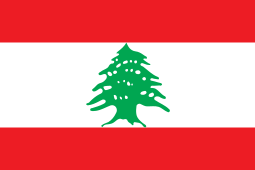
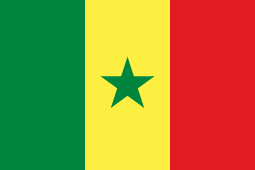





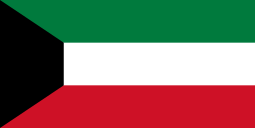




Cooperation agreements
Isfahan cooperates with:
See also
- List of the historical structures in the Isfahan province
- Islamic City Council of Isfahan
- 15861 Ispahan
- New Julfa
- Prix d'Ispahan
References
- Notes
- http://www.daftlogic.com/downloads/kml/10102015-9mzrdauu.kml%5B%5D
- https://www.amar.org.ir/english
- "Major Agglomerations of the World - Population Statistics and Maps". citypopulation.de. 13 September 2018. Archived from the original on 13 September 2018.
- "Isfahan Climate - IRAN TRAVEL, TRIP TO IRAN". www.irangazette.com. Retrieved 24 February 2020.
- "Population of Cities in Iran (2018)." The population of the greater metropolitan area is 5.1 million (2016 Census).
- "Isfahan Is Half The World". New York Times. Retrieved 23 July 2018.
- "Isfahan, Pre-Islamic-Period". Encyclopædia Iranica. 15 December 2006. Retrieved 31 December 2015.
- Strazny, P. (2005). Encyclopedia of linguistics (p. 325). New York: Fitzroy Dearborn.
- Iran: Provinces and Cities population statistics
- Sacred Precincts: The Religious Architecture of Non-Muslim Communities Across the Islamic World, Gharipour Mohammad, BRILL, Nov 14, 2014, p. 179.
- "Archived copy". Archived from the original on 23 October 2013. Retrieved 15 July 2013.CS1 maint: archived copy as title (link)
- Salma, K. Jayyusi; Holod, Renata; Petruccioli, Attilio; André, Raymond (2008). The City in the Islamic World. Leiden: Brill. p. 174. ISBN 9789004162402.
- Huff, D. "ARCHITECTURE iii. Sasanian Period – Encyclopaedia Iranica". www.iranicaonline.org. Encyclopaedia Iranica. Retrieved 16 March 2019.
- "Britannica.com".
- Battutah, Ibn (2002). The Travels of Ibn Battutah. London: Picador. p. 68. ISBN 9780330418799.
- Fisher, W.B.; Jackson, P.; Lockhart, L.; Boyle, J.A. : The Cambridge History of Iran, p. 55.
- electricpulp.com. "ISFAHAN vii. SAFAVID PERIOD – Encyclopaedia Iranica".
- Matthee 2012, p. 67.
- Aslanian, Sebouh (2011). From the Indian Ocean to the Mediterranean: The Global Trade Networks of Armenian Merchants from New Julfa. California: University of California Press. p. 1. ISBN 978-0520947573.
- Bournoutian, George (2002). A Concise History of the Armenian People: (from Ancient Times to the Present) (2 ed.). Mazda Publishers. p. 208. ISBN 978-1568591414.
- Iran Almanac and Book of Facts. 8. Echo Institute. 1969. p. 71. OCLC 760026638.
- "MSC at a Glance". Retrieved 19 July 2017.
- "Esfahan Steel Company A Pioneer in The Steel Industry of Iran". Retrieved 19 July 2017.
- Hesaco.com Archived 9 June 2007 at the Wayback Machine (from the HESA official company website)
- Pike, John. "HESA Iran Aircraft Manufacturing Industrial Company".
- "International conference held on investment opportunities in Iran tourism industry".
- DEPARTMENT-it@isfahancitycenter.com, IT. "صفحه اصلی بزرگترین مرکز خرید ایران".
- "About Isfahan City Center". Retrieved 16 August 2017.
- "Isfahan, Iran - Detailed climate information and monthly weather forecast". Weather Atlas. Yu Media Group. Retrieved 5 February 2020.
- "Esfahan Climate Normals 1961-1990". National Oceanic and Atmospheric Administration. Retrieved 8 April 2015.
- "Highest record temperature in Esfahan by Month 1951–2010". Iran Meteorological Organization. Archived from the original on 25 October 2016. Retrieved 8 April 2015.
- "Lowest record temperature in Esfahan by Month 1951–2010". Iran Meteorological Organization. Archived from the original on 4 March 2016. Retrieved 8 April 2015.
- Assari, A., Mahesh, T., Emtehani, M., & Assari, E. (2011). Comparative sustainability of bazaar in Iranian traditional cities: Case studies in Isfahan and Tabriz. International Journal on Technical and Physical Problems of Engineering (IJTPE)(9), 18-24.
- "Isfahan Jame(Congregative) mosque – BackPack". Fz-az.fotopages.com. Archived from the original on 3 March 2016. Retrieved 26 July 2009.
- "Castles of the Fields". Saudi Aramco World. Archived from the original on 7 October 2012. Retrieved 11 September 2012.
- "Isfahan Technical and Vocational Training Organisation". Web.archive.org. 8 October 2007. Archived from the original on 8 October 2007. Retrieved 23 April 2012.
- Assari, Ali; Erfan Assari (2012). "Urban spirit and heritage conservation problems: case study Isfahan city in Iran" (PDF). Journal of American Science. 8 (1): 203–209. Retrieved 7 January 2013.
- Ltd, DVV Media International. "Esfahan metro opens". Railway Gazette. Retrieved 2 August 2018.
- "نگاهی به زندگی و کارنامه هنری استاد جلال تاج". Retrieved 14 July 2017.
- "بیوگرافی علیرضا افتخاری". Archived from the original on 5 March 2014. Retrieved 14 July 2017.
- "بیوگرافی لیلا فروهر / عکس · جدید 96 -گهر". Retrieved 14 July 2017.
- "Hassan Kassai". Retrieved 14 July 2017.
- "بیوگرافی و شرح زندگی معین". Retrieved 13 August 2017.
- "بیوگرافی حسن شماعی زاده". Retrieved 31 August 2017.
- "شهسوار تار". Retrieved 15 July 2017.
- "سارا بهرامی+بیوگرافی". Retrieved 20 August 2018.
- "بیوگرافی اصغر فرهادی - زومجی". Archived from the original on 31 July 2016. Retrieved 15 July 2017.
- "بیوگرافی "محمد علی کشاورز" + عکس". Retrieved 20 August 2018.
- "بیوگرافی مهدی پاکدل و همسرش". Retrieved 20 August 2018.
- "بیوگرافی کیومرث پور احمد". Retrieved 20 August 2018.
- "بیوگرافی کامل سروش صحت + عکس". Retrieved 15 July 2017.
- "گفتگو با نصرت الله وحدت در بهار 90 سالگی". Retrieved 27 December 2018.
- "استاد محمود دهنوی". Retrieved 17 July 2017.
- "مروري كوتاه بر زندگينامه استاد محمود فرشچيان". Archived from the original on 19 October 2013. Retrieved 15 July 2017.
- "Abstract paintings and conceptual spiritual art by Freydoon Rassouli". Retrieved 15 July 2017.
- "زندگی نامه شهید بهشتی". Retrieved 31 August 2017.
- "با «محمدعلی فروغی» بیشتر آشنا شوید". 28 August 2018.
- "حسین خرازی که بود و چگونه به شهادت رسید؟". Retrieved 31 August 2017.
- "ناشنیدههایی از زندگی "ظریف" در روز تولدش". Retrieved 17 August 2017.
- "اشعار زیبا و کوتاه ژاله اصفهانی". Retrieved 27 October 2018.
- "افشین یداللهی را بهتر بشناسید". Retrieved 20 August 2018.
- "گزارشی از تاریخ قهرمانان ایران؛ پرسپولیس بهترین تیم تاریخ، سپاهان برترین تیم لیگ/ یک آبی در صدر". Retrieved 3 September 2017.
- "شهرهای خواهر". isfahan.ir (in Persian). Isfahan. Retrieved 18 June 2020.
- "Àsia-Pacífic" (in Catalan). Barcelona. Retrieved 18 June 2020.
- "Sister Cities". Gyeongju. Retrieved 18 June 2020.
- Dehghan, Maziar (2014). Management in IRAN. ISBN 978-600-04-1573-0.
Sources
- Yves Bomati and Houchang Nahavandi,Shah Abbas, Emperor of Persia,1587-1629, 2017, ed. Ketab Corporation, Los Angeles, ISBN 978-1595845672, English translation by Azizeh Azodi.
- Matthee, Rudi (2012). Persia in Crisis: Safavid Decline and the Fall of Isfahan. I.B.Tauris. ISBN 978-1845117450.CS1 maint: ref=harv (link)
External links
| Wikivoyage has a travel guide for Isfahan. |
| Wikimedia Commons has media related to Isfahan. |
- Isfahan official website
- Isfahan Metro
- Isfahan Geometry on a Human Scale - a documentary film directed by Manouchehr Tayyab (30 min)
| Preceded by Rey |
Capital of Seljuq Empire (Persia) 1051–1118 |
Succeeded by Hamadan (Western capital) Merv (Eastern capital) |
| Preceded by Qazvin |
Capital of Iran (Persia) 1598–1736 |
Succeeded by Mashhad |
| Preceded by Qazvin |
Capital of Safavid dynasty 1598–1722 |
Succeeded by - |
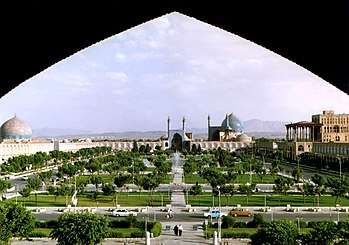
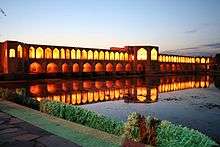
.jpg)


